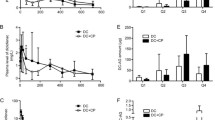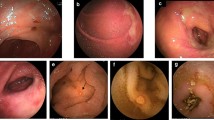Abstract
The ability of non-steroidal anti-inflammatory drugs (NSAIDs) to injure the small intestine has been well established in humans and animals. Proton pump inhibitors (PPIs) are frequently prescribed to reduce gastric and duodenal injury caused in high-risk patients taking NSAIDs. However, scarce information is available concerning the effects of PPIs on intestinal damage induced by NSAIDs, and the suppression of gastric acid secretion by PPIs is hard to provide any protection against the damage caused by NSAIDs in the small intestine. The present study was designed to examine the effects of intragastric treatment of two PPIs widely used in clinical practice, namely omeprazole and pantoprazole, on the intestinal damage induced by administration of diclofenac in rat. Male SD rats were treated with omeprazole or pantoprazole for 9 days, with concomitant treatment with anti-inflammatory doses of diclofenac on the final 5 days. The anatomical lesion, villous height, the thickness, and the section area of small intestine were quantitatively analyzed. The change of ultrastructural organization was observed. Endotoxin level in blood was measured by photometry. Epidermal growth factor was observed by immunohistochemistry. Omeprazole and pantoprazole didn’t decrease the macroscopic and histologic damage induced by diclofenac in the rat’s small intestine. In the two PPI groups, villous height was (89.6 ± 11.8 and 92.6 ± 19.3 μm) lower than which of the control group (P < 0.05). The thickness became thinning, and the section area became small. LPS levels in the portal blood of omeprazole and pantoprazole were (4.36 ± 1.26 and 4.25 ± 1.17 EU/ml), significantly higher than in controls (P < 0.05). The EFG of PPI group descended significantly compared with the control group (P < 0.05). Omeprazole and pantoprazole cannot protect the small intestine from the damage induced by diclofenac in the conscious rat. PPIs cannot repair NSAID-induced intestinal damage at least in part because of significant lesion in mechanical barrier function and reduction in epidermal growth factor.






Similar content being viewed by others
References
Baum C, Kennedy DL, Forbes MB (1985) Utilization of non-steroidal anti-inflammatory drugs. Arthr Rheum 28:686–692
O’Brien VM, Bagdy GF (1985) Rare adverse reactions to non-steroidal anti-inflammatory drugs. J Rheumatol 12:13–20
Baltoyiannis G, Christodoulos N, Mitsis M, Stephanou D, Ioannou H, Nousias V, Kappas AM (2001) A comparative experimental study of the effects of diclofenac and ketoprofen on the small-bowel mucosa of canines. Res Exp Med (Berl) 200(2):125–135
Allison MC, Howatson AG, Torrance CJ, Lee FD, Russell RI (1992) Gastrointestinal damage associated with the use of non-steroidal anti-inflammatory drugs. N Engl J Med 327:749–754
Bjarnason I, Zanelli G, Smith T, Prouse P, Williams P, Smethurst P, Delacey G, Gumpel MJ, Levi AJ (1987) Nonsteroidal anti-inflammatory drug-induced intestinal inflammation in humans. Gastroenterology 93:480–489
Sidhu R, Sanders DS, McAlindon ME, Kapur K (2006) Capsule endoscopy for the evaluation of nonsteroidal anti-inflammatory drug induced enteropathy: United Kingdom pilot data. Gastrointest Endosc 64:1035
Maiden L, Thjodleifsson B, Seigal A, Bjarnason II, Scott D, Birgisson S et al (2007) Long-term effects of nonsteroidal anti-inflammatory drugs and cyclooxygenase-2 selective agents on the small bowel: a cross-sectional capsule enteroscopy study. Clin Gastroenterol Hepatol 5:1040–1045
Lai KC, Lam SK, Chu KM, Hui WM, Kwok KF, Wong BC, Hu HC, Wong WM, Chan OO, Chan CK (2003) Lansoprazole reduces ulcer relapse after eradication of Helicobacter pylori in nonsteroidal anti-inflammatory drug users: a randomized trial. Aliment Pharmacol Ther 18:829–836
Simon WA, Sturm E, Hartmann HJ, Weser U (2006) Hydroxyl radical scavenging reactivity of proton pump inhibitors. Biochem Pharmacol 71:1337–1341
Kuroda M, Yoshida N, Ichikawa H, Takagi T, Okuda T, Naito Y, Okanoue T, Yoshikawa T (2006) Lansoprazole, a proton pump inhibitor, reduces the severity of indomethacin-induced rat enteritis. Int J Mol Med 17:89–93
Thomson RD, Lestina LS, Bensen SP, Toor A, Maheshwari Y, Ratcliffe NR (2002) Lansoprazole associated microscopic colitis: a case series. Am J Gastroenterol 97:2908–2913
Goldstein JL, Eisen GM, Lewis B, Gralnek IM, Zlotnick S, Fort JG (2005) Investigators. Video capsule endoscopy to prospectively assess small bowel injury with celecoxib, naproxen plus omeprazole and placebo. Clin Gastroenterol Hepatol 3:133–141
Graham DY, Opekun AR, Willingham FF et al (2005) Visible small-intestinal mucosal injury in chronic NSAID users. Clin Gastroenterol Hepatol 3:55–59
Maiden L, Thjodleifsson B, Theodors A et al (2005) A quantitative analysis of NSAID-induced small bowel pathology by capsule endoscopy. Gastroenterology 128:1172–1178
Fujimora S, Gudis K, Takahashi Y et al (2010) Distribution of small intestinal mucosal injuries as a result of NSAID administration. Eur J Clin Invest 40:504–510
Chan FK, Lanas A, Scheiman J, Berger MF, Nguyen H, Goldstein JL (2010) Celecoxib versus omeprazole and diclofenac in patients with osteoarthritis and rheumatoid arthritis (CONDOR): a randomised trial. Lancet 376(9736):173–179
McCarthy DM (2009) GI bleeding: problems that persist. Gastrointest Endosc 70:225–228
Wallace JL, Keenan CM, Gale D, Shoupe TS (1992) Exacerbation of experimental colitis by nonsteroidal antiinflammatory drugs is not related to elevated leukotriene B4 synthesis. Gastroenterology 102:18–27
Chin CJ, Mcardle AH, Brown R et al (1970) Intestinal mucosal lesions in low flow states. I. A morphological, hemodynamic, and metabolic reappraisal. Arch Surg 101:478–483
Whiteland JL, Shimeld C, Nicholls SM, Easty DL, Williams NA, Hill TJ (1997) Immunohistochemical detection of cytokines in paraffin-embedded mouse tissues. J Immunol Methods 210:103–108
Wolfe MM, Lichtenstein DR, Singh G (1999) Gastrointestinal toxicity of nonsteroidal anti-inflammatory drugs. N Engl J Med 340:1888–1899
Bjarnason I, Hayllar J, MacPherson AJ et al (1993) Side effects of nonsteroidal anti-inflammatory drugs on the small and large intestine in humans. Gastroenterology 104:1832–1847
Wallace JL (2008) Prostaglandins, NSAIDs, and gastric mucosal protection: why doesn’t the stomach digest itself? Physiol Rev 88:1547–1565
Sigthorsson G, Crane R, Simon T, Hoover M, Quan H, Bolognese J, Bjarnason I (2000) COX-2 inhibition with rofecoxib does not increase intestinal permeability in healthy subjects: a double blind crossover study comparing rofecoxib with placebo and indomethacin. Gut 47:527–532
Lanas A, Scarpignato C (2006) Microbial flora in NSAID-induced intestinal damage: a role for antibiotics? Digestion 73(S):136–150
Reuter BK, Davies NM, Wallace JL (1997) Nonsteroidal anti-inflammatory drug enteropathy in rats: role of permeability, bacteria and enterohepatic circulation. Gastroenterology 112:109–117
Thiefin G, Beaugerie L (2005) Toxic effects of nonsteroidal antiinflammatory drugs on the small bowel, colon, and rectum. Joint Bone Spine 72:286–294
Langtry HD, Wilde MI (1998) Omeprazole. A review of its use in Helicobacter pylori infection, gastro-esophageal reflux disease and peptic ulcers impaired by non-steroidal anti-inflammatory drugs. Drugs 56:447–486
Hawkey CJ, Karrasch JA, Szczepañski L, Walker DG, Barkun A, Swannell AJ, Yeomans ND (1998) Omeprazole compared with misoprostol for ulcers associated with nonsteroidal anti-inflammatory drugs. Omeprazole versus Misoprostol for NSAID-induced Ulcer Management (OMNIUM) study Group. N Engl J Med 338:727–734
Wallace JL, Syer S, Denou E, de Palma G, Vong L, McKnight W, Jury J, Bolla M, Bercik P, Collins SM, Verdu E, Ongini E (2011) Proton pump inhibitors exacerbate NSAID-induced small intestinal injury by inducing dysbiosis. Gastroenterology 141(4):1314–1322
Playford RJ, Wright NA (1996) Why is epidermal growth factor present in the gut lumen? Gut 38:303–305
Buret A, Olson ME, Gall DG, Hardin JA (1998) Effects of orally administered epidermal growth factor on enteropathogenic Escherichia coli infection in rabbits. Infect Immun 66:4917–4923
Hardin JA, Chung B, O’Loughlin EV, Gall DG (1999) The effect of epidermal growth factor on brush border surface area and function in the distal remnant following resection in the rabbit. Gut 44:26–32
Riegler M, Sedivy R, Sogukoglu T, Cosentini E, Bischof G, Teleky B, Feil W, Schiessel R, Hamilton G, Wenzl E (1996) Epidermal growth factor promotes rapid response to epithelial injury in rabbit duodenum in vitro. Gastroenterology 111:28–36
Acknowledgments
This research received financial support from the national natural youth fund (No. 81102708).
Author information
Authors and Affiliations
Corresponding author
Rights and permissions
About this article
Cite this article
Zhang, S., Chao, Gq. & Lu, B. Proton pump inhibitors are not the key for therapying non-steroidal anti-inflammatory drugs-induced small intestinal injury. Rheumatol Int 33, 2513–2521 (2013). https://doi.org/10.1007/s00296-013-2756-6
Received:
Accepted:
Published:
Issue Date:
DOI: https://doi.org/10.1007/s00296-013-2756-6




